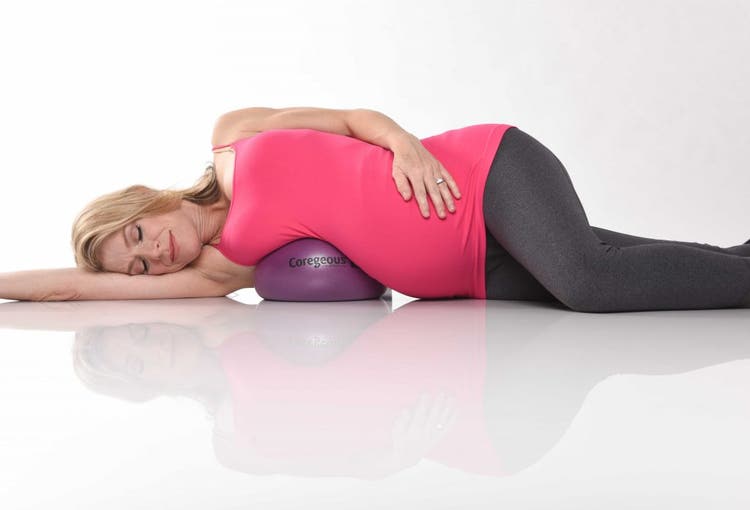New Fitness Rules for Pregnant Women

After more than a decade, ACOG released revised exercise guidelines for women who are expecting. Here’s what you should know …
Pregnancy is an exciting and empowering time in a woman’s life. It is also a time of many questions and learning about a changing body and a changing lifestyle. With friends, co-workers, family members and even the Internet all doling out conflicting advice as to what’s right in order to deliver a healthy baby, what’s a woman to do?
The answer: Listen to the ancient wisdom of her body, the advice of her doctor and recommendations of the American Congress of Obstetricians and Gynecologists or ACOG, which is the go-to organization for pregnancy information, facts and research.
Up until recently, the exercise guidelines for women offered by ACOG (last published in 2002) were considered by many to be out of date and women and doctors were left to follow old rules. Finally, in late 2015, ACOG released new exercise recommendations for women who are pregnant, and these updates were much anticipated.
The biggest changes to the guidelines
In the original ACOG guidelines from 2002, women who were pregnant were overly cautious about exercise and were advised not to introduce any new activity into their lives. This was interpreted by physicians and women across the world that if they were not already active, it was not advisable to start a new workout routine once they became pregnant. If they wanted to exercise for a healthy pregnancy, they found themselves in a catch-22 being told to stay inactive.
However, most women agree that pregnancy is an amazing time to renew their commitment to healthy living. And while a healthy pregnancy truly begins before conception, it’s an opportunity to reinforce healthy lifestyle practices in all areas of life including sleep, nourishment and movement. Now ACOG agrees and all pregnant women are encouraged to exercise and be active during all three trimesters.
“These new recommendations do more than recognize the importance of exercise – they recognize that the benefits of exercise can be experienced by women who have not been exercising or have never exercised before,” says Ilene Bergelson, Owner of Lifemoves Health and creator of Training for the Sport of Motherhood and EmpowerSpeak programs.
The revised ACOG guidelines suggest that women engage in moderate-intensity movement for about 20 to 30 minutes most days of the week. Recommended activities include walking, swimming, stationary cycling, low-impact aerobics, modified yoga or Pilates, running, jogging, racquet sports and strength training – all of which are considered safe for pregnant women.
“As a society, we are not as active as we should be,” said Annette Lang, Owner of Annette Lang Education Systems, who is a personal trainer in New York City. “And pregnant women are in this predicament as well, so the new information advising all women to exercise is crucial.”
While it’s still advised that women get medical clearance from their doctors before working out, as long as the body feels good – activity is recommended.
“It’s a huge shift from 14 years ago,” says Jill Miller, creator of Yoga Tune Up and Treat While You Train, who recently gave birth to a healthy baby. “The new recommendations also champion core strengthening, exercise for obese patients and even recommend weight training and running. There are guidelines to exertion and quantity of exercise time.”
Another change in the guidelines is the mention of heated classes. Due to the growing popularity of studio classes over the years, the ACOG workout guidelines now say that pregnant women should avoid hot yoga and hot Pilates classes.
How pregnant women should feel while working out
The “talk test” is an excellent gauge of activity, say the experts and ACOG. Women should be able to freely talk while exercising, or not be so out of breath that they can’t carry on a conversation.
“In my opinion, a pregnant woman should pay very close attention to how she feels physically and emotionally while being in her pregnant body in every trimester. This means engaging in subtle internal dialogue and sensing how you move through space, the messages your body parts and organs are communicating, and of course the intriguing movements of her growing fetus,” says Miller. “Be a host of your own inner baby carriage and attune to yourself as never before. This ‘tuning in’ will prepare you for the miracle of labor, birth and mothering.”
As a note, Miller was recently pregnant and said throughout her pregnancy, her routine adjusted organically. When something started feeling “not ok” on her transforming body, she would find a modification. Her squat stance became wider, she started to slowly lift less weight and she constantly focused on listening to her body and mind during every single workout. Miller credits her work with self-myofascial soft tissue release as well as breath exercises in keeping her totally pain free throughout her entire pregnancy. (You can check out more from Jill Miller’s movement tips on 24Life here.)
In addition to the exertion levels, it’s also about being prepared in any situation. Bergelson recommends moms who exercise always have access to the three F’s: food, fluid and facilities.
What to watch out for
ACOG and the experts agree, there are a few things pregnant women need to be extra careful to spot while exercising or on days when they are extra active …
- Profuse sweating. If you ever feel profuse sweating, you and the baby likely need hydration. If you feel you are sweating more than normal, you may be diverting too many of your resources away from the baby, and this can happen when you are exercising too hard or are in a hot environment. That’s why hot yoga and hot Pilates are not advised, says ACOG.
- Contact sports or risk of falling. Pregnant women should not engage in activities in which they can be hit by equipment or another person or fall. Gymnastics, skiing, scuba diving and sky diving are not advised, says ACOG.
- Fatigue. Plan extra rest periods as your body needs them. Your body is changing and busy throughout all of the trimesters, so you’ll need to recover more often.
- The shakes. If you ever feel shaky, stop, have a snack and some water and rest.
- Bleeding. Any bleeding from anywhere during any workout is a means to stop. If you see spotting, let your medical professional know immediately and don’t resume physical activity until you’ve been given the all clear to resume.
- Lying flat. While the new guidelines don’t say you cannot lay flat, after the first trimester, it may be better to prop your head and shoulders on a wedge to help with blood-flow. Make sure you don’t get up too quickly from the lying position, says Bergelson.
- Heavy weights. Try not to lift super heavy weights or do any exercise that requires you to hold your breath.
Important exercises for pregnant women
- Elevator breathing exercise. As you exhale, engage your pelvic floor and continue drawing in an up for one breath. Then inhale and totally relax. Repeat. During this exercise you should feel your core engage.
- Lying to standing. Practice getting up from lying down position by rolling to your side first and engaging your deep abdominals throughout.
- Strength moves. Pull-ups, deadlifts and chest presses are important functional ways to build strength while pregnant, says Miller.
- Dynamic stretching. Shoulder flowing and ribcage rotations are great ways to increase mobility.
- Self-myofascial release. Use therapy balls (a soft-inflated kids ball will do) to roll alongside the waist and ribcage while lying down. Use a pliable rubber ball to massage and release tightness and tissue in the glutes, says Miller. Here’s a shot of Miller in action …

Photo credit: Samantha Jacoby Photography and Jill Miller.
“We still have a long way to go in obtaining conclusive data on what are safe limits for physical activity while pregnant, but these recommendations are a very welcome step,” says Bergelson. “As future research tells us more, future recommendations can be more detailed and apply to more women, taking into account their age, the way they conceived (in vitro, traditional), and other considerations.”
All the experts agree, if you recently became pregnant and want to say active – keep in contact with your medical team regarding what you are doing for movement and activity. Consider working with a personal trainer and movement experts who specialize in pre- and post-natal care. Most importantly, spend time listening to your energy daily, learning to breathe deeply with a restricted diaphragm and set aside time to understand and train your changing body—especially training your posture and developing strength to manage the new load on your body, support your pelvic floor and get in touch with your deep abdominals. Stay active!
For the full recommendations, visit ACOG today.
Cover photo credit: Thinkstock, iStock AnaBGD.